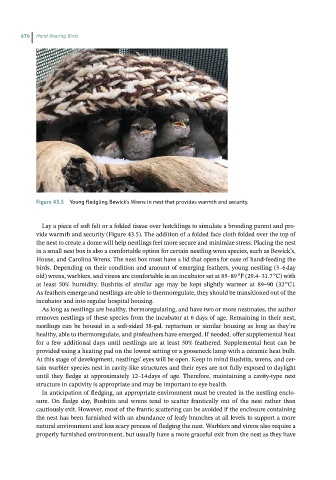Page 675 - Hand rearing birds second
P. 675
676 Hand-Rearing Birds
Figure 43.5 Young fledgling Bewick’s Wrens in nest that provides warmth and security.
Lay a piece of soft felt or a folded tissue over hatchlings to simulate a brooding parent and pro-
vide warmth and security (Figure 43.5). The addition of a folded face cloth folded over the top of
the nest to create a dome will help nestlings feel more secure and minimize stress. Placing the nest
in a small nest box is also a comfortable option for certain nestling wren species, such as Bewick’s,
House, and Carolina Wrens. The nest box must have a lid that opens for ease of hand‐feeding the
birds. Depending on their condition and amount of emerging feathers, young nestling (5–6 day
old) wrens, warblers, and vireos are comfortable in an incubator set at 85–89 °F (29.4–31.7 °C) with
at least 50% humidity. Bushtits of similar age may be kept slightly warmer at 89–90 (32 °C).
As feathers emerge and nestlings are able to thermoregulate, they should be transitioned out of the
incubator and into regular hospital housing.
As long as nestlings are healthy, thermoregulating, and have two or more nestmates, the author
removes nestlings of these species from the incubator at 6 days of age. Remaining in their nest,
nestlings can be housed in a soft‐sided 38‐gal. reptarium or similar housing as long as they’re
healthy, able to thermoregulate, and pinfeathers have emerged. If needed, offer supplemental heat
for a few additional days until nestlings are at least 50% feathered. Supplemental heat can be
provided using a heating pad on the lowest setting or a gooseneck lamp with a ceramic heat bulb.
At this stage of development, nestlings’ eyes will be open. Keep in mind Bushtits, wrens, and cer-
tain warbler species nest in cavity‐like structures and their eyes are not fully exposed to daylight
until they fledge at approximately 12–14 days of age. Therefore, maintaining a cavity‐type nest
structure in captivity is appropriate and may be important to eye health.
In anticipation of fledging, an appropriate environment must be created in the nestling enclo-
sure. On fledge day, Bushtits and wrens tend to scatter frantically out of the nest rather than
cautiously exit. However, most of the frantic scattering can be avoided if the enclosure containing
the nest has been furnished with an abundance of leafy branches at all levels to support a more
natural environment and less scary process of fledging the nest. Warblers and vireos also require a
properly furnished environment, but usually have a more graceful exit from the nest as they have

